10 Things to Do in Ávila, Spain | Ávila Day Trip Itinerary

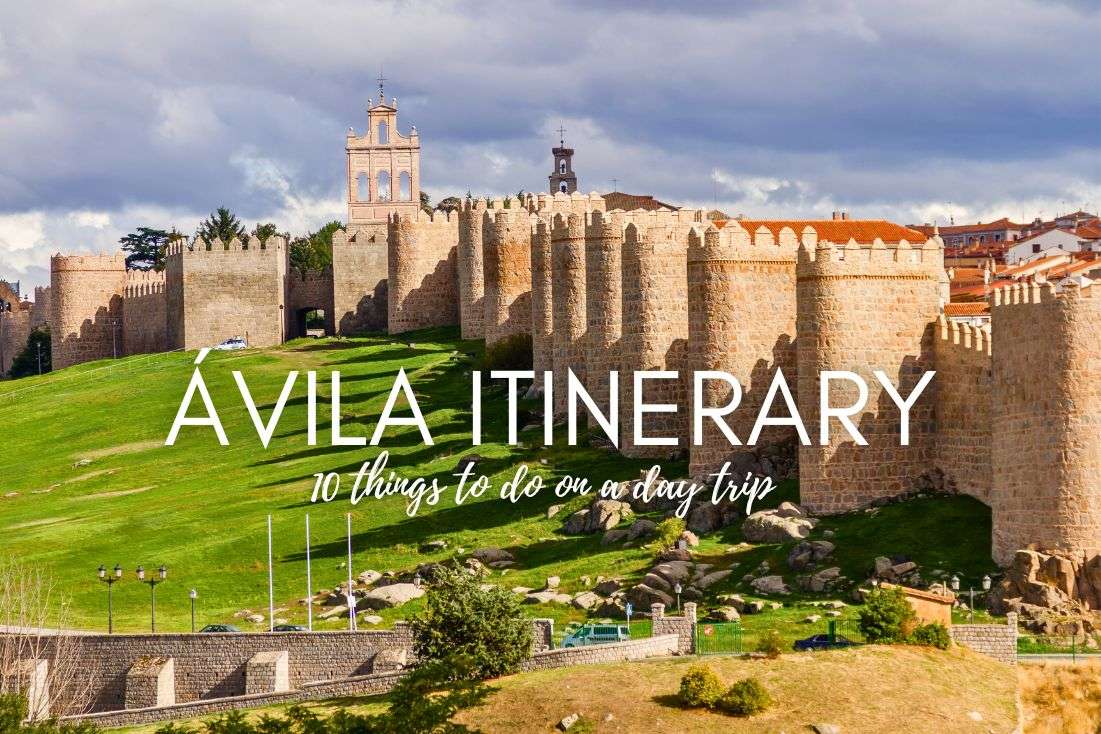
Throughout my travels in Spain’s Castile and La Mancha regions, I unexpectedly fell in love with Ávila. Honestly, there's a lot to see in this compact early medieval town. I would even rank it among the top cities in Europe to visit, maybe even thinking about spending more than a day there.
Plus, Ávila has some hefty fun facts which I love—for example, it has the biggest illuminated monument in the world! And is the highest provincial capital in Spain, meaning it's relatively chilly compared to the other cities in the region. It’s also where St. Theresa was born.
We visited Ávila as a day trip from Madrid. I expected a lot from the various towns and nothing from Madrid, and my premonition came true (have you seen my Madrid itinerary?). And Ávila was the biggest positive surprise of the bunch. The magnificent walls really help. And for some reason, it had a Southwest US vibe for me outside the central part of the city. It's also notable for having the highest density of Romanesque and Gothic buildings in Spain. (Not surprising, as the early kingdoms here belonged to the Goths, who took down Rome.) Ávila is a city of kings—almost all of them, as Spain had more kingdoms in its history than there are in Europe today!
Finally, be ready for a lot of convents and monasteries. Seriously, after visiting Ávila, you’ll almost feel ready to join one.
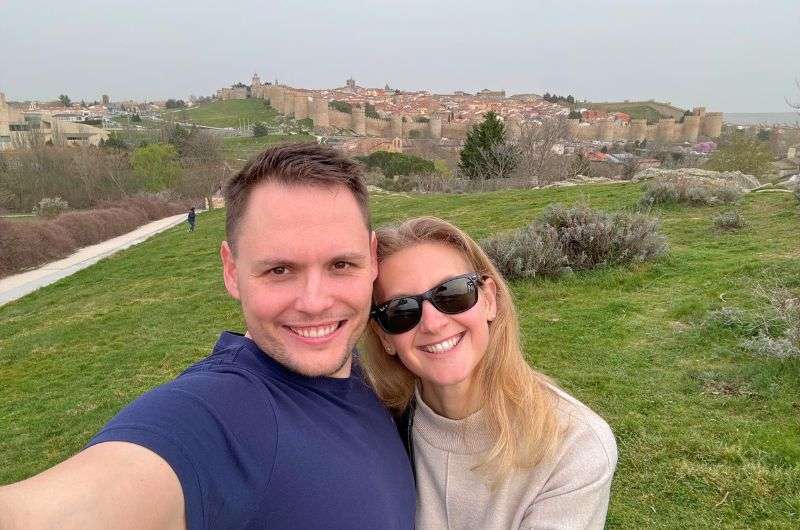
We have just arrived and are ready to explore Ávila!
Top tips for visiting Ávila
- Rent a car: I highly recommend renting a car in Madrid and driving to Ávila from there. It allows you to explore at your own pace. Organized day trips from Madrid can be rushed, as they often combine Ávila with Segovia, and both cities deserve a full day each. Trains from Madrid to Ávila are an option but slightly inconvenient. There’s easy parking near the city center. Plus, there are a few spots to visit outside the city center, so a car comes in extra handy for those.
- Bring a sweater: At 1,132 meters above sea level, Ávila is significantly cooler than lower-altitude Madrid or Toledo, even during the usually warm spring and fall seasons.
- Buy a city pass: This pass allows you to enter most of the important city monuments. We found out about it after visiting most of them, so look for it ahead of time. You can even buy Avila Pass online at the cost of EUR 15 per person.
- Take a break: Many of the sights in Ávila are closed between 12 pm–4 pm. Spain and its siesta time, huh? Makes no sense for tourists, but you need to be ready for it at some of Ávila’s tourist spots, too.
Things to do in Ávila
Here's my list of Ávila’s must-see sights, from the absolute best to still-really-good things to see:
- Ávila Cathedral
- The Walls of Ávila
- Cuatro Postes (the best viewpoint)
- Royal Monastery of St. Thomas
- Basilica of St. Vincent (Basílica de los Santos Vicente)
- Convent of San José Carmelitas Descalzas (Convento de San José)
- Monastery of Incarnation (Monasterio de la Encarnación)
- Church, convent, and birthplace of Saint Teresa (Basilica y casa natal de Santa Teresa)
- Palace of Polentinos (Palacio de Polentinos)
- Plaza Mercado Chico
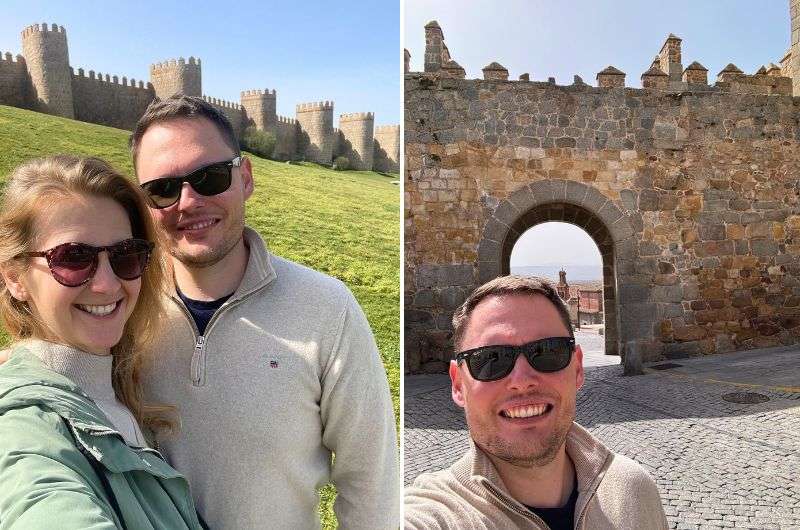
Get ready for the iconic walls, the cathedral, churches, and more
I’ve put all of these places (and more) into the itinerary below so you can see them all in a logical order while on a day trip from Madrid (or even if you’re staying overnight). I don’t know about you, but I hate backtracking unnecessarily! I’ll also tell you how long to expect to spend in each spot so you can plan your time well, as well as include opening times and prices.
Orientation in Ávila
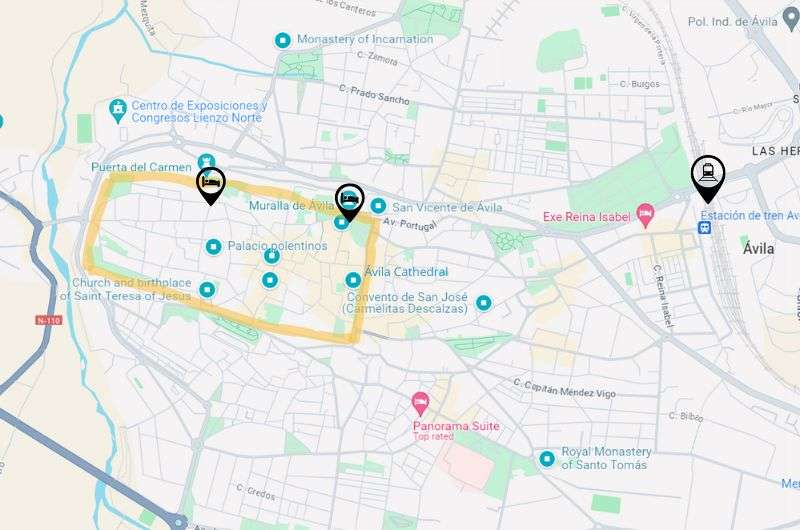
The city walls are outlined in orange. The train station is on the right, and the two top hotels I highly recommend in Ávila are Sofraga Palacio, World Hotels Crafted and Parador de Ávila
Ávila’s historical center is surrounded by the famous medieval walls, which are well-preserved and a highlight of any visit. The main sights are within walking distance of each other, but some of the more out-of-center locations will require a car to get to comfortably.
Parking is available near the city center, and most major attractions are signposted. Keep in mind that some monuments close for a few hours in the afternoon (Spain's famous siesta time!), so plan your visits accordingly. Enjoy strolling through the narrow, cobbled streets and soaking up the medieval atmosphere.
If you want to stay the night, you can stay within the walled part of the city at Sofraga Palacio, World Hotels Crafted. Check it out.
Stop 1: The Walls of Ávila (Murallas de Ávila)
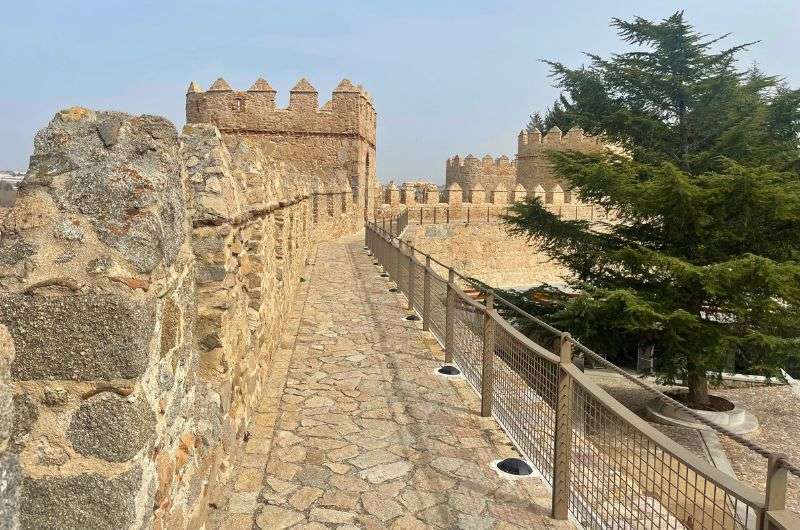
Murallas de Ávila, the city walls
Time spent here: 1 hour
Opening hours: 10 am–5:30 pm
Price: EUR 5 (free entry until 3:30 pm)
Kick off your day in Ávila with those famous walls. These are the best-preserved city walls in the world, stretching for about 2,5 km (1.5 mi) with 87 towers and 9 gates. For a construction project from 1090, this was quite the achievement and showcases Ávila's importance in the Middle Ages.
There’s a large tourist parking lot outside of the walls and parking within the city is next to impossible, so don’t even think about trying.
Start your wall walk at the main entrance behind the cathedral, where you can get an audioguide that takes you through 16 stops along the walls. There are also signs along the walls and close to the gates that provide extra info. It’s easy to see why these walls are a UNESCO World Heritage site.
The walls date back to Roman times and have been meticulously preserved. They’re a fantastic example of medieval fortifications that would protect the medieval town within. Because let’s face it, walls were usually built to protect something, not just sitting randomly in the middle of a field. Storming these walls would have been incredibly tough back in the day!
From the walls, you get gorgeous views of Gothic buildings all around and learn fascinating stories, like of women defending the city against the Moors.
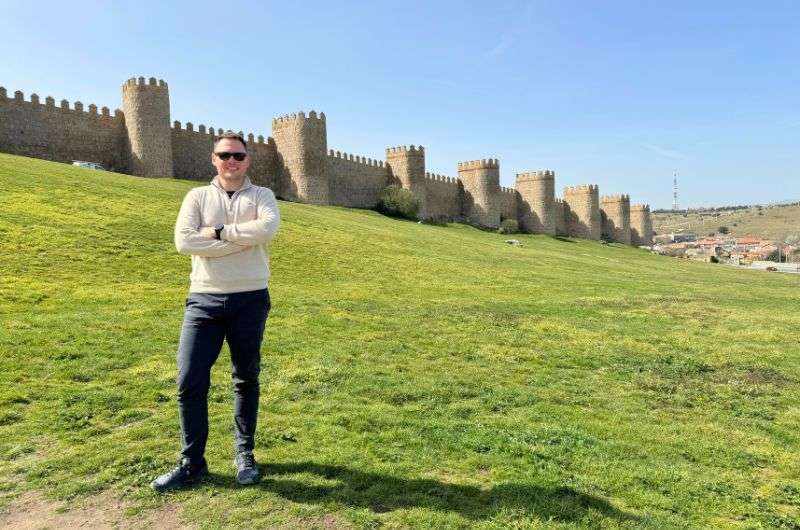
Well-preserved walls from Roman times still unshakably protect the town today (but I have to say I got in just fine)
The legend: According to the legend, the Moors besieged Ávila. When it seemed that the city would fall, the women of Ávila came up with a cunning plan. They decided to disguise themselves as soldiers to bolster the appearance of the city’s defenses. The sight of additional troops on the walls gave the impression that the city's defenses were stronger than anticipated, demoralizing the Moors and causing them to abandon the siege, thereby saving the city.
Pro tip: The walls are particularly stunning at night when they’re lit up—they hold the title for the largest illuminated monument in the world. This is why you get in for free during the day but need to pay EUR 5 after 3:30 pm.
Stop 2: Palace of Polentinos (Palacio de Polentinos)
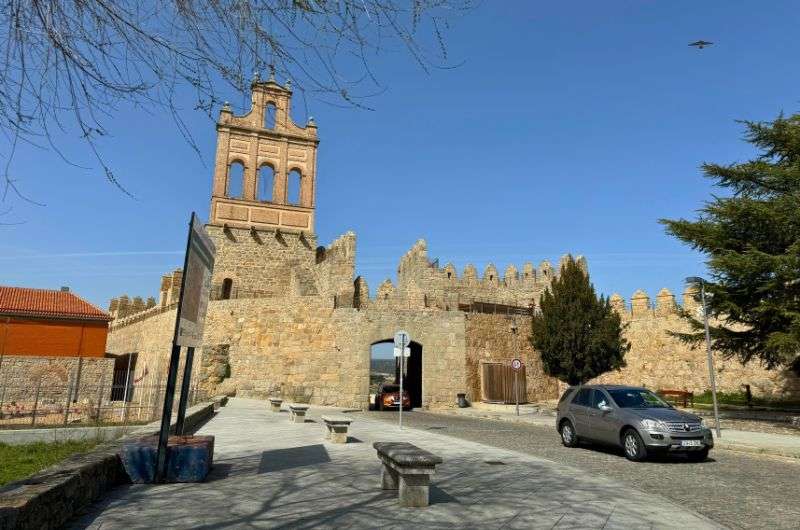
Palace of Palentinos is currently the headquarters of the General Military Archive
Distance from last stop: 500 meters (about an 8-minute walk)
Time spent here: 20 minutes
Opening hours: 8 am–3 pm
Price: Free
Walk 5 minutes over to Palacio de Polentinos, which originally served as a military academy and now houses the General Military Archive. From the outside, it might look like just another medieval house, but inside, it offers a rich dive into Spanish military history. If you know me, you know this is my jam! But no worries even if this isn’t your normal cup of tea—the museum presents history with a fun twist. The interactive exhibits, including some cool VR experiences, make it an engaging visit.
The museum is small but packed with artifacts, uniforms, and documents. No tanks or the like, calm down. Despite most of the signage being in Spanish, a little help from Google Translate can go a long way. Or Spanish skills, like I have (yes, that was a flex).
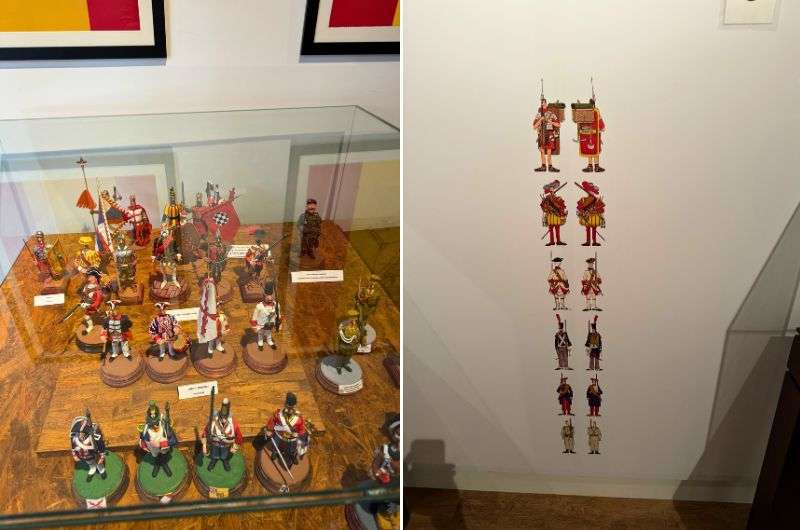
In the museum you will find, for example, these figures of soldiers and displays of different types of uniforms
The staff here are friendly and knowledgeable, always ready to share interesting tidbits (again, ideally if you can speak Spanish). Don’t miss the informative video they show inside–it’s a great introduction to the exhibits. You guessed it—in Spanish!
Fun fact: The Spanish word for salary, "salario," comes from the Latin word for salt, "sal," because Roman soldiers were often paid in salt.
Stop 3: Church, convent, and birthplace of Saint Teresa (Basilica y casa natal de Santa Teresa)
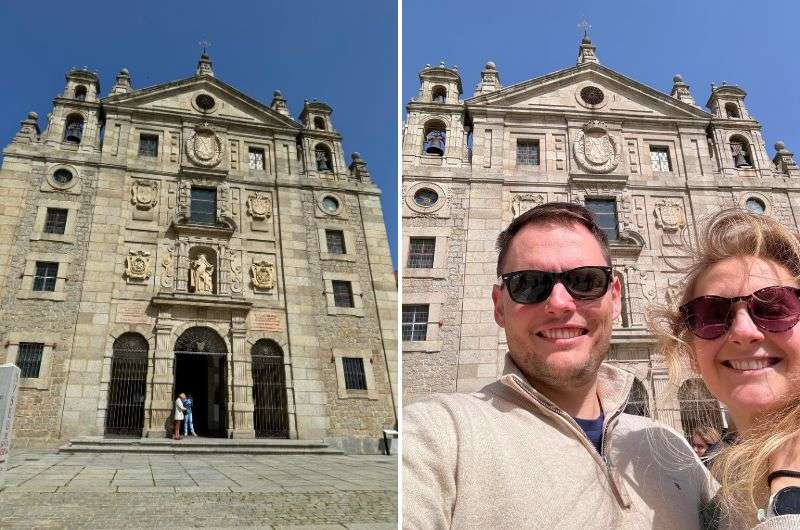
Next up is the Basilica de Santa Teresa
Distance from last stop: 250 m/0.2 mi (about a 4-minute walk)
Time spent here: 30 minutes
Opening hours: 10 am–2 pm, 4 pm–7 pm, closed on Mondays
Price: EUR 3 (cash only)
Next, head over to the Convent and Museum of Saint Teresa. You can only pay with cash here, so make sure you have a few euros on hand. Right from the start, you’re greeted by medieval music, which follows you throughout the tour, setting the perfect ambiance.
There’s a church, convent, and a museum built on the site where Saint Teresa of Ávila was born and lived, experiencing miracles and mystical experiences in this very spot, which adds a sprinkle of historical magic.
St. Teresa’s miracles: Saint Teresa had a hotline to the divine, seeing visions of Jesus, Mary, and various saints. She allegedly levitated during prayer. Witnesses swore it happened, so who are we to argue? And imagine this: An angel stabs you in the heart with a golden lance, and instead of calling 911 (or 112 for my Europeans), you feel an overwhelming sense of divine love. Teresa described this as the transverberation of her heart. It's so famous that Bernini even sculpted it. Teresa’s prayers even had some serious healing power. Move over, modern medicine!
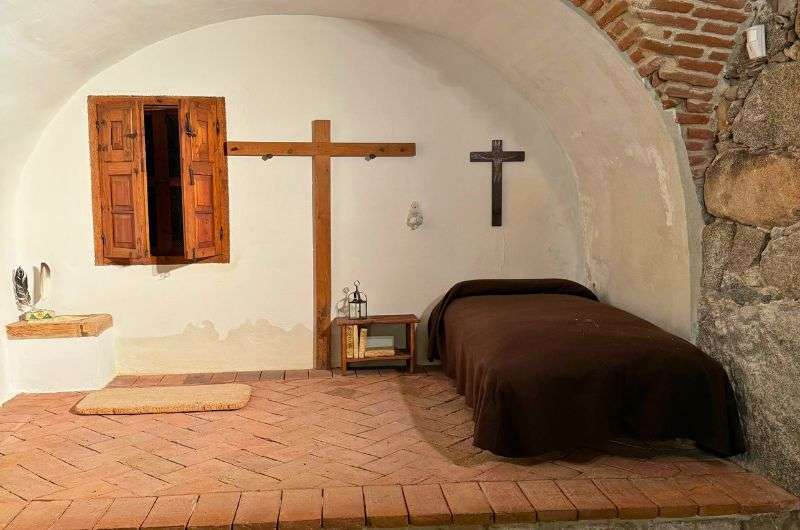
This was St. Theresa's chamber
Though the guide speaks English, the signs are only in Spanish. So, either brush up on your Spanish or be prepared to use Google Lens. If you’re religious, this place will resonate even more with you—just don’t get your hopes up for any miracles. For the rest of us, it's still a fascinating peek into history (and into how some peoples’ minds work!).
The convent has a beautiful façade right by the gate, setting the scene for the treasures inside. You can also visit the reliquary, which is dedicated to Saint Joseph. By some lucky coincidence, we visited on Saint Joseph’s Day. Inside the reliquary, you'll find the classic slightly macabre relics, like surprisingly well-preserved fingers and bones. I’ve been to so many sacred buildings in my travels that these things don’t even surprise me anymore!
They don’t allow photos, so you’ll have to rely on your memory (or sketching skills, if you're feeling artistic—how good are you at drawing human fingers?). The church building itself might not win any beauty contests, but the historical artifacts make it worth the visit. Plan to spend about 30 minutes here.
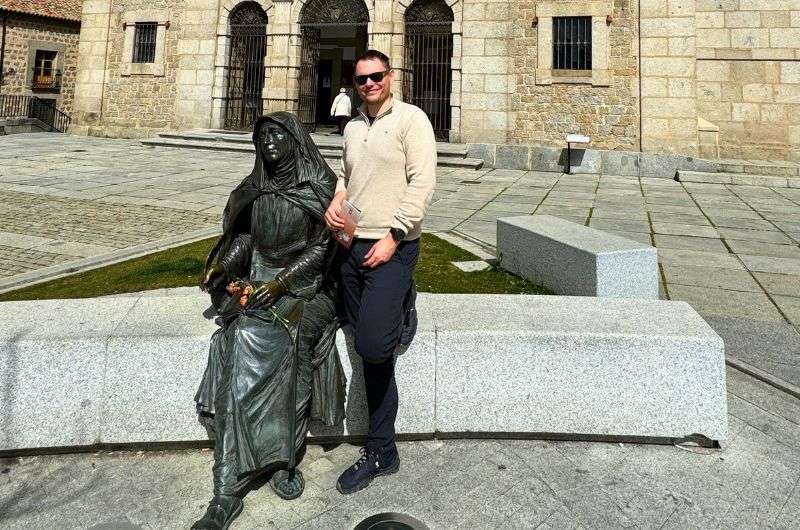
Me and Mother Teresa, two saints
Fun fact: Saint Teresa was the first of only 4 women to be named a Doctor of the Church. Many priests from this convent went to the Americas to spread Christianity during the time of the conquest. So, you’re literally standing where history was made.
Now that you’ve filled your quota of historical and slightly eerie sights, let's move on to the next stop!
Stop 4: Plaza Mercado Chico (main square)
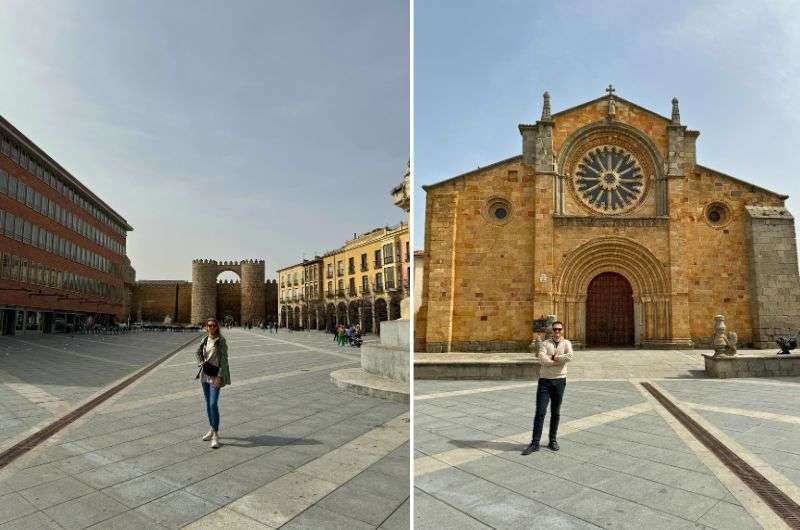
A quick walk around the Plaza Mercado Chico
Distance from last stop: 350 m/0.2 mi (about a 4-minute walk)
Time spent here: 45 minutes
Opening hours: Open 24 hours
Price: Free
Ávila’s main square, Plaza Mercado Chico (also called Plaza Mayor) is… just a square. There’s a church and old buildings with arches lining the whole thing… Not sure what else I’m supposed to write about it. But, since you’ve already seen a fair bit of Ávila’s top things to do, you deserve a coffee break. Once you take a quick peak at the square, pop into the nearby Comedia Café for a coffee break—it’s called the best coffee in Ávila, so try it out. If you’ve had any coffee in Spain before this, you’re in for a treat. None of that undrinkable black water!
Stop 5: Ávila Cathedral (Catedral de Ávila)
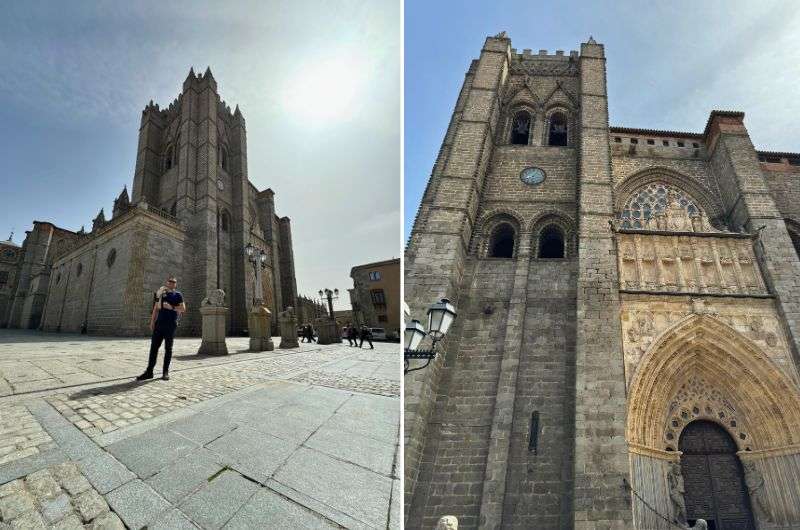
The Cathedral of Ávila
Distance from last stop: 400 m/0.3 mi (about a 7-minute walk)
Time spent there: 1.5 hours
Opening hours: 10 am–9 pm (Sundays from 12:30 pm)
Price: EUR 8 + EUR 3 for the tower
Let’s walk off that café indulgence by exploring the Ávila Cathedral. This is no cookie-cutter cathedral—Ávila Cathedral is one of the most significant and impressive cathedrals in Spain. Why? Because I loved it; it’s one of the best cathedrals I’ve ever been to. Also, because it’s old—it’s the first Gothic cathedral in Spain, built in the 12th century. This place is massive and a visual delight. One of the coolest features is that the bricks are exposed, giving it a raw look.
As you stroll around, you’ll notice that the photography angles here are uncommonly great, so keep your camera ready and snappin’. Check out the impressive limestone wall from the 16th century that looks much newer and of incredible quality. The rear nave, with its brickwork and colors cast by the stained glass windows, is absolutely stunning, resembling South American cathedrals.
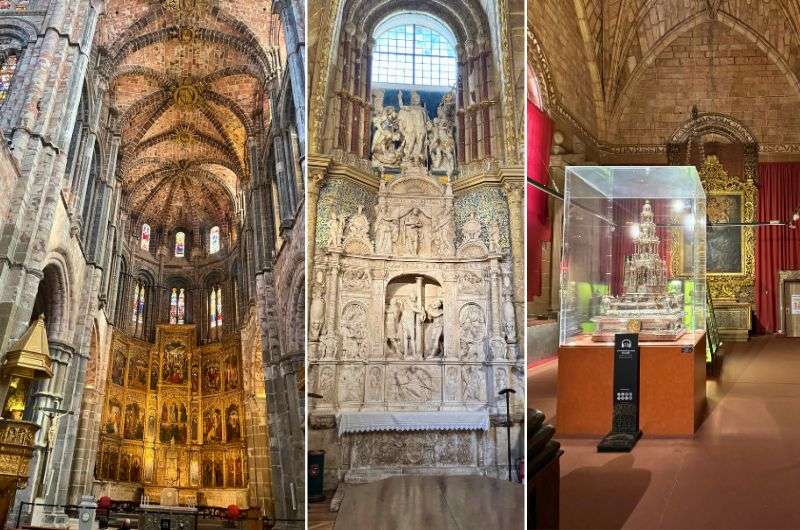
The beautiful interior of Avila Cathedral
The tourist experience at the Ávila Cathedral is second to none, there are so many things to see and do.
- Make sure to grab the audio guide (free with your ticket)—it’s packed with fun facts and skips the boring stuff. It even explains how medieval Spaniards weren’t racists, which somehow surprised me.
- There’s a detailed timeline of religious history. It’s a timeline, people! Timelines and fun facts do it for me. How about you?
- There’s a lovely walled garden that’s perfect for a peaceful stroll after all that historical overload.
- They’ve got VR glasses for a stop the end of tour. You get to fly through Ávila and into the cathedral, which is totally worth putting your hygiene standards aside for (I seriously wished I could wipe those things before putting them on my face!). Kids love it, and let's be honest, so did I. It’s like Universal Studios but holier.
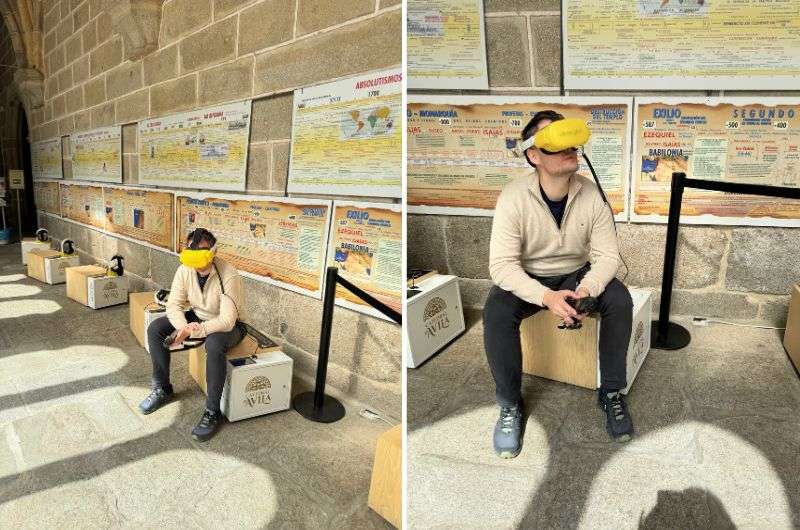
This kept me entertained for a while!
Ávila Cathedral is full of secret nooks and crannies, making it much larger than it appears at first glance. Plan to spend about 90 minutes here, which is way longer than your average cathedral tour but totally worth it. Even the sculptures in the cathedral are mind-blowingly detailed. Drawing a person is one thing, but sculpting them to look this real is next level.
On to the next stop! Who’s hungry?
Lunch stop: Steak or seafood? Both!
I had one of the best steaks ever at Taberna de los Verdugo. It’s a 3-minute walk from the cathedral. Service was professional and friendly, and the food was divine! Fitting in a town full of monasteries. Besides glorious steaks, they also serve seafood.
If you’re staying the night at the Sofraga Palacio, World Hotels Crafted, you’re now right across the street from the hotel, so it’s the perfect time to go freshen up before you continue your Ávila itinerary. For day-trippers, it’s straight off to the next stop.
Stop 6: Convent of San José Carmelitas Descalzas (Convento de San José)
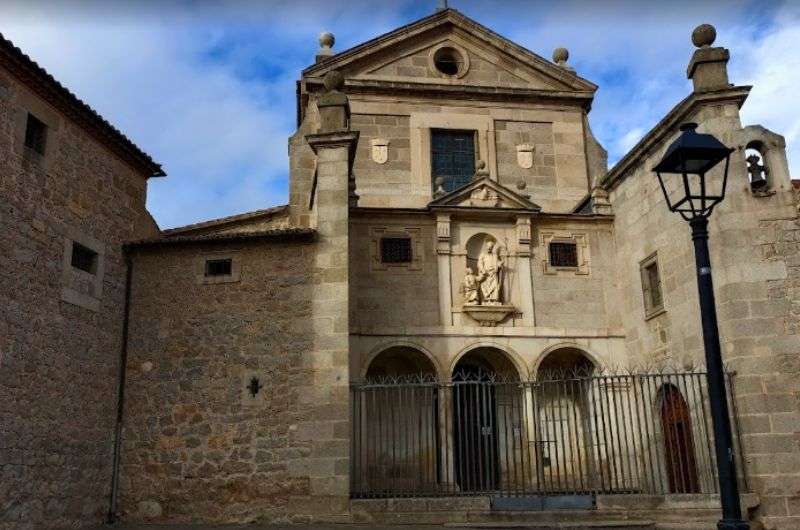
Convento de San José
Distance from last stop: 500 m/0.4 mi (about an 8-minute walk)
Time spent here: 30 minutes
Opening hours: unclear
Price: Free
After lunch, you’re heading to your first stop outside of Ávila’s walls—the Convent of San José, the first convent founded by Saint Teresa in 1562. Unfortunately, it was closed during our visit, but let me paint you a picture based on the information I've gathered.
The convent is known for its simplicity and austerity—think cold, small, and unembellished. The main church, built posthumously in honor of Saint Teresa, is also austere but larger. It holds the only altar dedicated to Saint Joseph in all of Spain. The convent is a cloistered one, meaning the Carmelite nuns live a life of seclusion, devoted to prayer and contemplation. What a life!
Inside the museum, which is located next to the church, you can explore old rooms of the convent, view paintings, sculptures, and various belongings and relics of Saint Teresa. It should give you a better idea of what life is like for a Carmelite nun.
Pro tip: Be prepared for varying levels of attentiveness from the staff. Some visitors report getting a piece of paper and being sent off with little direction, while others have had great experiences. It seems Spanish speakers might get a bit more love here.
Stop 7: Royal Monastery of St. Thomas (Monasterio de Santo Tomás)
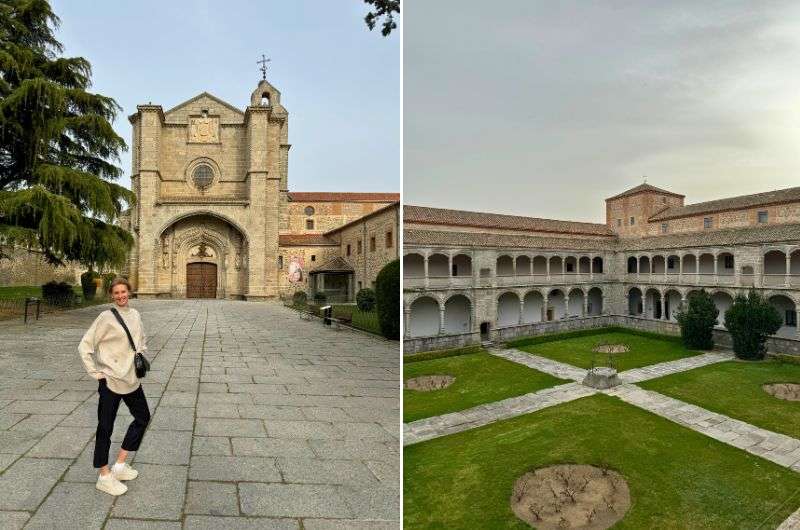
This monastery is not exactly in the city center but definitely worth seeing
Distance from last stop: 800 m/0.4 mi (about a 10-minute walk or a quick drive)
Time spent here: 1 hour minimum
Opening hours: 10:30 am–2 pm and 3:30 pm–7:30 pm (in July and August from 10:30 am – 9 pm with no siesta)
Price: EUR 4
A bit further from the city center, but worth the trip, is the Royal Monastery of St. Thomas. This is the king’s and queen’s cloister, so you know it’s going to be grand. It’s a significant monastery in Spain, blending Romanesque and Gothic styles, which means it’s super old and super impressive.
There’s plenty of street parking around, so bring your car from this point, you’ll need it for the next stops on the itinerary.
From the outside, it might look a bit plain, but inside, it's a whole different story. The complex is organized around several cloisters and includes a church, a former royal palace, a former university, and a couple of museums. Talk about a multifunctional space!
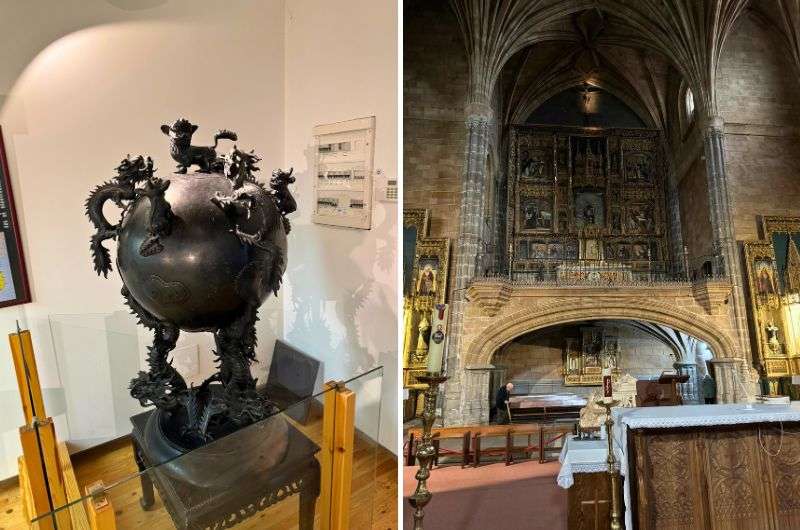
I recommend touring the Royal Monastery of St. Thomas with an audio guide
Get the audio guide that’s an absolute delight, providing all the historical context you could want, and in a language you can understand—everything on the signs inside the monastery is in Spanish.
Ferdinand and Isabella's connection: Ferdinand and Isabella, the Catholic monarchs, were instrumental in unifying Spain and financing Columbus’s voyage to the New World. Their son, Prince Juan, who tragically died at just 19, is buried here.
The entry fee is just EUR 4, audio guide included. Walking through the monastery, you can almost hear the echoes of monks shuffling through the halls. The cloisters are serene and picturesque. The church inside is surprisingly large yet modestly decorated compared to the cathedral, and the gardens are simple as well, but it’s all very beautiful. Besides Prince Juan, other members of Spanish royalty are buried here too. The former royal palace within the complex is a glimpse into the lavish lifestyles of the Spanish monarchy.
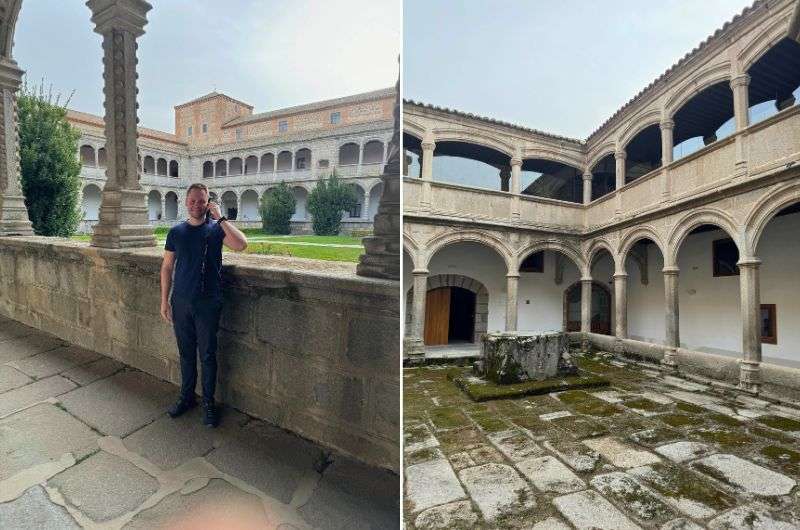
I loved this monastery!
You also get access to the monastery’s fascinating oriental museum and then a museum of natural sciences—this one is a little bit of everything and seems random, is random, but hey, I like museums, so I was happy, though a little confused. The funny thing is that they have more Japanese artifacts here than you might find in some parts of Japan. Go figure!
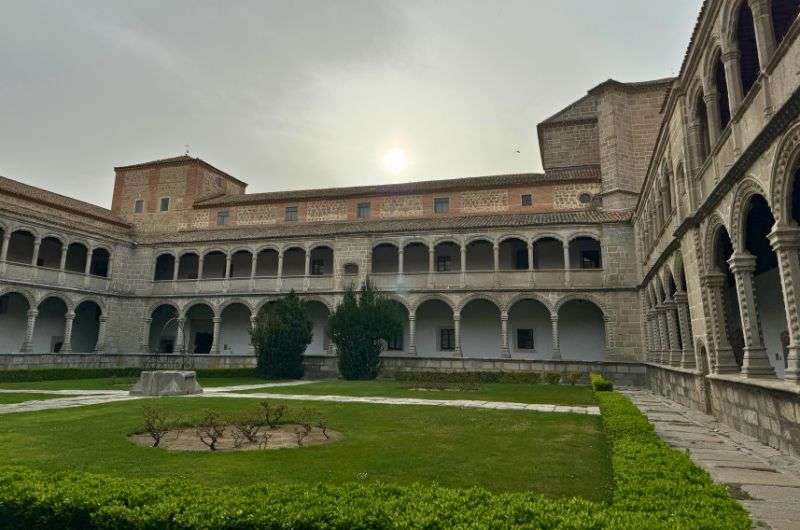
The Royal Monastery of St. Thomas
Tip: You’ll want to spend at least 60 minutes here to take it all in. The sheer size of the church and the variety of things to see inside make it a pretty intense visit, so make sure to give yourself extra time if you realize that you can’t seem to leave Monasterio de Santo Tomás just yet and need to wander some more.
Stop 8: Cuatro Postes Viewpoint
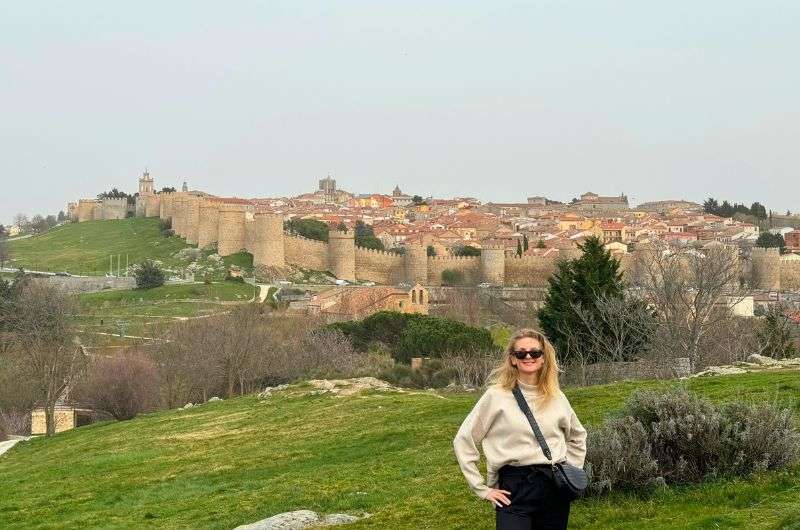
The best views of Ávila!
Distance from last stop: 3 km/2 mi (an 8-minute drive)
Time spent here: 20 minutes
Opening hours: Open 24 hours
Price: Free
Given that one of the top things to do in Ávila, Spain, is look at the iconic city walls, it makes sense that you’ll want a good viewpoint to do that from. Enter Cuatro Postes, the ultimate photo op spot in Ávila. Also, there’s plenty of space for a short walk to stretch your legs after all that sightseeing.
Adequate parking, well-maintained grounds, and informative signs (in English, finally!) make this a must-see, please-the-tourists stop. It’s a popular spot, so expect company, but people are generally respectful about taking turns for the best photo spots. The giant “Ávila” letters are a huge hit for those Instagram moments… who do you think took the better shot?!
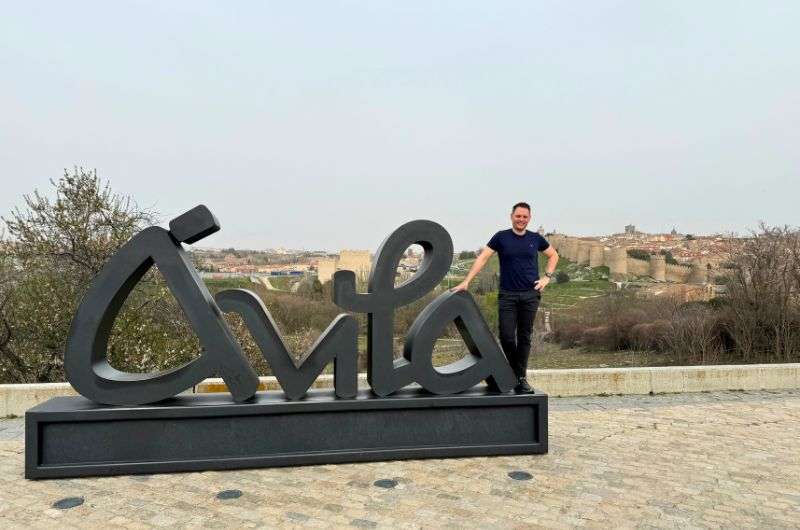
Who did it better: Option number 1 (thank you in advance for all your votes)
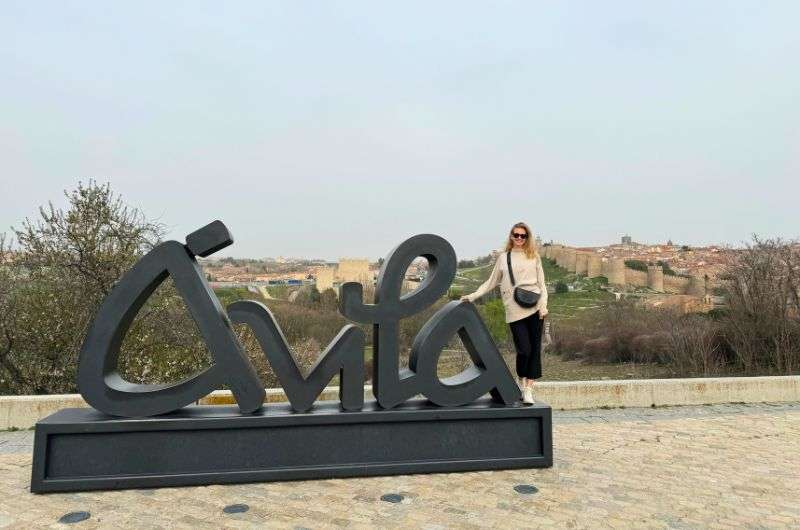
Who did it better: Option number 2
Tip: The sunset views from here are phenomenal. Picture the walled city bathed in golden light, then gradually lighting up as dusk falls. If that doesn’t make you feel all warm and fuzzy inside, I don’t know what will.
Stop 9: Monastery of Incarnation (Monasterio de la Encarnación)
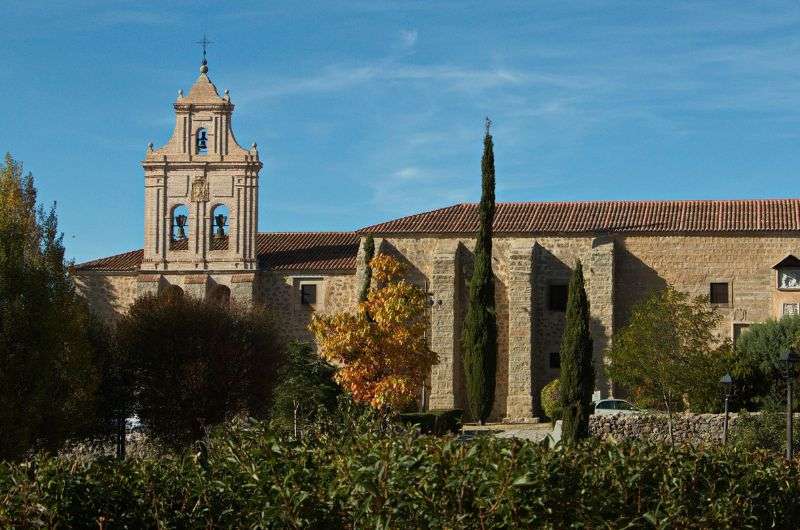
The Monastery of Incarnation
Distance from last stop: 2 km/1.2 mi (a 5-minute drive)
Time spent here: 30 minutes
Opening hours: Weekdays 9:30 am–1:30 pm and 4 pm–5:30 pm; on weekends it’s 10 am–1 pm and 4 pm–6 pm)
Next up, the Carmelite Monastery of the Incarnation. This place is yet another gem, but let’s be real, Ávila is practically a convent conveyor belt. You might start feeling like you’re in a monastery marathon!
This is where Mother Teresa first entered as a nun and lived for almost 40 years. So, even if you feel you’ve seen enough monasteries, you’ll die of FOMO if you skip this one. You can see where St. Teresa prayed, the room where she and St. John of the Cross would hang out (or levitate, apparently), the place she saw baby Jesus appear, and other significant Teresa-related spots. Don’t miss the small museum for an in-depth look at her life and learn about how she started the reform of all Carmelite monasteries because she hated how it normally worked in them. The patio and garden in front are perfect for a quiet moment of reflection, assuming you’re not already in convent overload.
The Monastery of Incarnation is a working monastery, so you will see nuns around, and if you visit during mass, people report their singing to sound like angels. We walked around on our own, but some of the nuns will guide people around if interested.
Brief history: The monastery was founded in 1478 inside the town’s walls but was moved outside in the 16th century. Originally built on a former Jewish cemetery, the new site opened in 1515. The chapel of La Transverberación was added later, not opening until 1717. The monastery features Baroque style, with a Latin-cross layout, a single nave, and an 18th-century interior. The large steeple from 1715 stands out on the south side.
In this monastery, Saint Teresa received counsel from notable figures like Francisco de Borja, Juan de la Cruz, and Pedro de Alcántara. This monastery was also ground zero for the Reform of the Carmelite Order. The museum inside houses fascinating relics, including a drawing of Christ on the Cross by St. John of the Cross.
Stop 10: Basilica of St. Vincent (Basílica de los Santos Vicente)
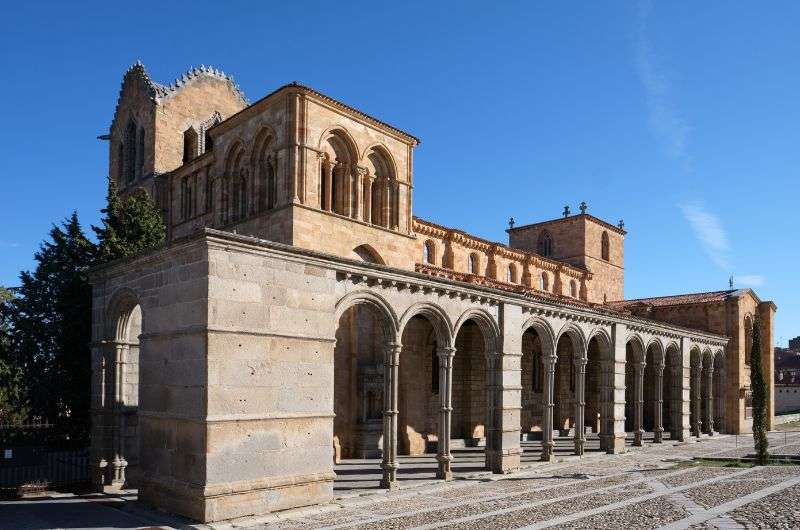
Basílica de los Santos Vicente
Distance from last stop: 1 km/0.6 mi (a 15-inute walk or a short drive)
Time spent here: 20 minutes
Opening hours: 10 am–1:30 pm and 4 pm–6:30 pm, Sundays 4 pm–6 pm
Price: EUR 3
Lastly, we have the Basílica de los Santos Vicente, a beautiful Romanesque church from the 12th century. Located near the entrance of Ávila, just outside the city walls, this basilica is a mix of Romanesque style with some Gothic influences.
While the outside might not scream “grand basilica,” step inside, and you’ll see why this is one of the top things to do in Ávila. The colorful stones used in its construction create make the interior pop. Built on the site where Saints Vincent, Sabina, and Cristeta were martyred, the basilica’s cenotaph is a key highlight with its intricate carvings.
Stay the night in Ávila:
Ávila has a lot to offer and overnighting makes sense if you ask me. Spending just one day there may not be enough, especially if you don’t want to spend morning until evening getting monastery overload. While I personally did Ávila, Spain, as a day trip from Madrid, now that I’ve seen it, I’d happily book a hotel and give it an extra half-day if I could.
Try this hotel:
4* Sofraga Palacio, World Hotels Crafted: Within the city walls, incredibly cozy design, parking.
>> Read more: The best day trips from Madrid <<
FAQ 1: Is Ávila worth visiting?
Ávila is packed with so many things to do that a day trip from Madrid might just not cut it. Trust me, and I rarely say this: consider spending the night. The city’s medieval charm, architecture, history, perfect weather, and great restaurants are worth the extra time. Plus, it gives you the chance to see the walls illuminated at night, which is simply unforgettable.
FAQ 2: What is Ávila, Spain famous for?
Ávila is famous for its iconic medieval walls, which are some of the best-preserved in the world. This UNESCO World Heritage site also boasts an impressive array of Romanesque and Gothic architecture, including the first Gothic cathedral in Spain. Additionally, Ávila is known for its connection to Saint Teresa of Ávila (aka Mother Teresa), a prominent mystic and reformer. The city's unique blend of historical, architectural, and spiritual significance makes it a must-visit.
FAQ 3: How much time do you need in Ávila, Spain?
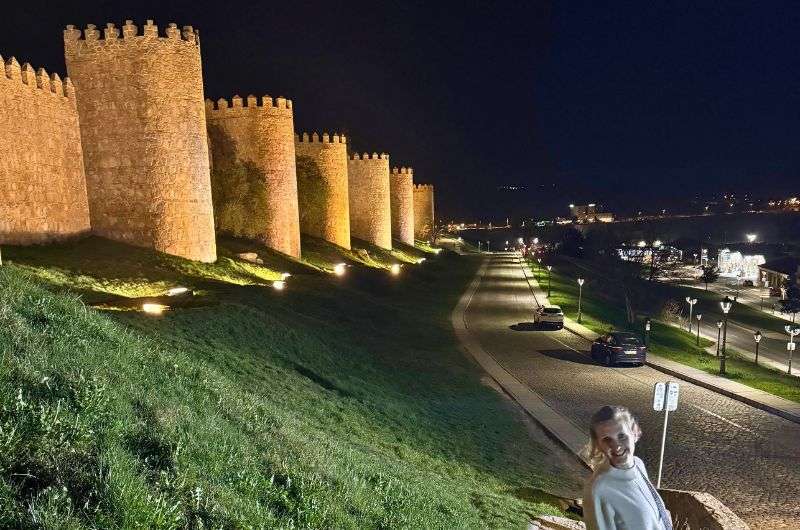
Goodbye, Ávila! Make sure to stay and see the walls lit up at night
While you can get a good taste of Ávila in a day trip from Madrid, I recommend spending at least a night to fully appreciate its medieval charm and stunning architecture. If you're really pressed for time, prioritize the key highlights, but an overnight stay will give you a more relaxed and immersive experience. Sofraga Palacio, World Hotels Crafted and Parador de Ávila are two hotels that I’d happily spend a night at in Ávila Spain.
FAQ 4: Can you visit Ávila and Segovia in one day?
No, I wouldn't recommend squeezing Ávila and Segovia into a single day. Each city has enough attractions to warrant a full day on its own. Rushing through them would do a disservice to both. See my guide for Segovia to see what I mean.
FAQ 5: Can you walk on the walls of Ávila?
Yes, you can walk on the walls of Ávila, and it's one of the highlights of any visit. These well-preserved medieval walls surround the historical center of the city stretch for about 2.5 km (1.5 mi). They offer spectacular views of the city and its surroundings. Make sure to get the audioguide and read the signs along the way explaining the historical significance.
FAQ 6: Is Ávila a day trip from Madrid?
Absolutely, Ávila makes for a perfect day trip from Madrid. It’s about 110 km (68 mi) away, which is roughly a 1.5-hour drive or train ride. However, if you can spare the time, consider staying overnight to fully soak in the city's medieval magic and enjoy the illuminated walls at night. But yes, it’s totally doable as a day trip if that’s all the time you have.
FAQ 7: Is there a train from Madrid to Ávila?
Yes, there is a train from Madrid to Ávila. You can catch a direct train from Madrid's Chamartín Station, and the journey takes about 1.5 hours. It's a convenient and scenic way to reach Ávila, with multiple trains running daily and departures at least once every hour.
You might also be interested in reading:
- 10-Day Spain Itinerary
- 10 Best Places to See in Mallorca
- 5 days in Barcelona (with day trips)
- How to Visit the Alhambra in Granada
- Andalusia Itinerary: Southern Spain in 10 Days
This post contains affiliate links. I earn a small commission if you make bookings through my links, at no additional cost to you. Thank you for your support!


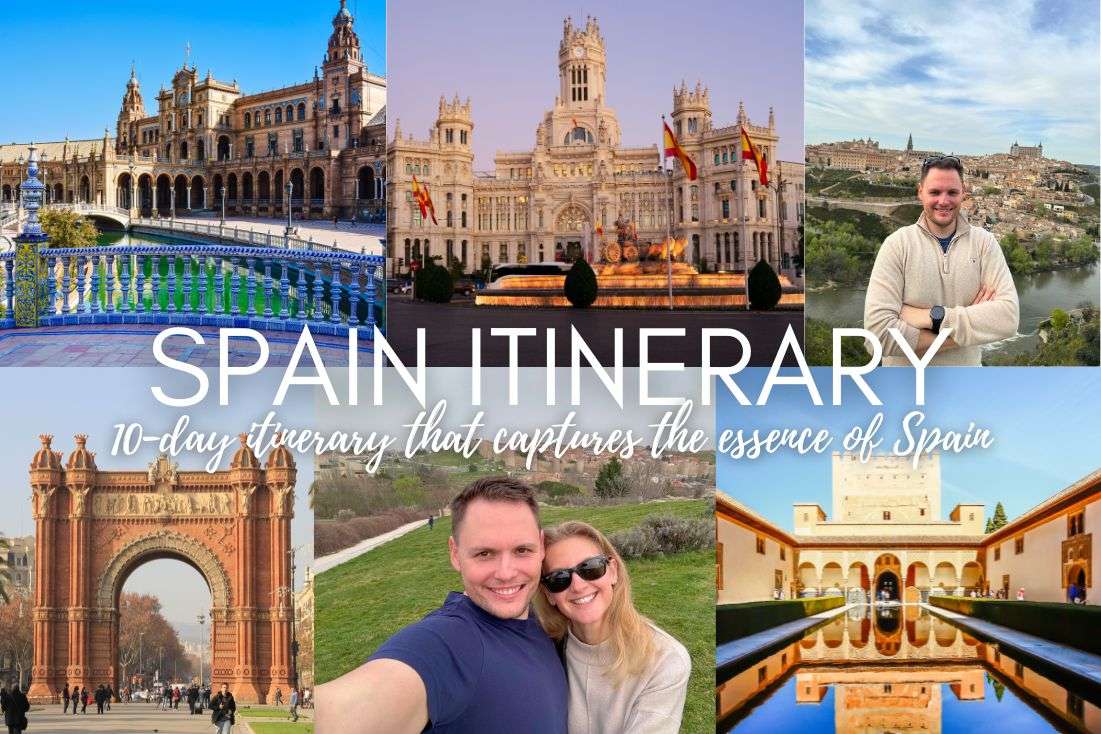
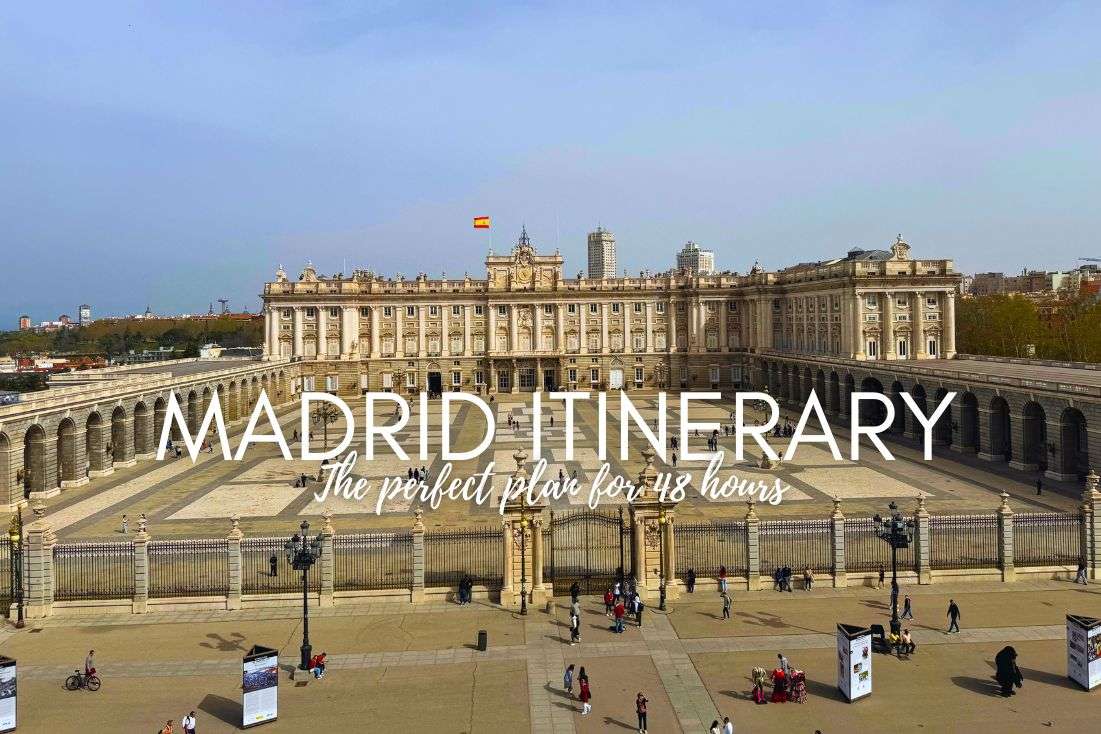






Comments | Thoughts? Give us a shout!